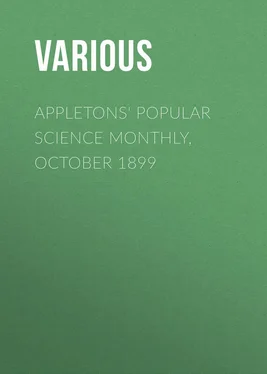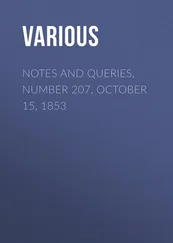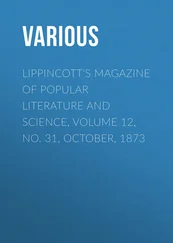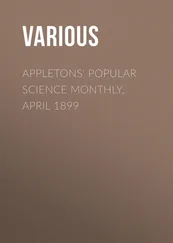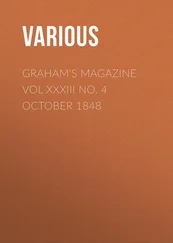Various - Appletons' Popular Science Monthly, October 1899
Здесь есть возможность читать онлайн «Various - Appletons' Popular Science Monthly, October 1899» — ознакомительный отрывок электронной книги совершенно бесплатно, а после прочтения отрывка купить полную версию. В некоторых случаях можно слушать аудио, скачать через торрент в формате fb2 и присутствует краткое содержание. Издательство: Иностранный паблик, Жанр: periodic, foreign_edu, на английском языке. Описание произведения, (предисловие) а так же отзывы посетителей доступны на портале библиотеки ЛибКат.
- Название:Appletons' Popular Science Monthly, October 1899
- Автор:
- Издательство:Иностранный паблик
- Жанр:
- Год:неизвестен
- ISBN:нет данных
- Рейтинг книги:3 / 5. Голосов: 1
-
Избранное:Добавить в избранное
- Отзывы:
-
Ваша оценка:
- 60
- 1
- 2
- 3
- 4
- 5
Appletons' Popular Science Monthly, October 1899: краткое содержание, описание и аннотация
Предлагаем к чтению аннотацию, описание, краткое содержание или предисловие (зависит от того, что написал сам автор книги «Appletons' Popular Science Monthly, October 1899»). Если вы не нашли необходимую информацию о книге — напишите в комментариях, мы постараемся отыскать её.
Appletons' Popular Science Monthly, October 1899 — читать онлайн ознакомительный отрывок
Ниже представлен текст книги, разбитый по страницам. Система сохранения места последней прочитанной страницы, позволяет с удобством читать онлайн бесплатно книгу «Appletons' Popular Science Monthly, October 1899», без необходимости каждый раз заново искать на чём Вы остановились. Поставьте закладку, и сможете в любой момент перейти на страницу, на которой закончили чтение.
Интервал:
Закладка:
The art of basketry was never brought to a high state among the Hopis, for they confine themselves chiefly to the manufacture of large shallow trays and rough baskets made of the long, pliable leaves of the yucca or of some other fiber. These answer all ordinary domestic requirements. From the reddish-brown branches of a willowlike bush which grows near, the Hopi mother interweaves a cradle board for her children. This cradle is peculiar in its shape, and especially so in its construction, and differs greatly from that in use among the plains Indians. Another singular point to be noted is the fact that this cradle board is not often strapped to the back, but is usually in the arms, or, more often still, is placed on the floor by the side of the mother as she works. The Oraibi mesa, like other table-lands of Tusayan, is destitute of water. The nearest spring is in the valley at the foot of the mesa nearly a mile away. From before sunrise to ten o'clock of every day there is an almost unbroken line of water carriers going and coming from the spring, bending under the weight of a large jar which they carry on their back by means of a blanket, the ends of which are tied in a knot on their forehead. No wonder these women grow prematurely old. Winter for them, however, has its advantages, for they have an ingenious way of utilizing the snow to save them from the necessity of going down the mesa for water. One of the most extraordinary sights I saw was that of a Hopi woman and her little girl trudging along, each bent almost to the ground under the weight of an immense snowball. These they were carrying home on their backs, enveloped in a blanket. About half a mile from the pueblo, back on the mesa, reservoirs have been scooped out in the soft sandstone, which are often partially filled by the spring rains, but the water soon becomes brackish and is not potable, but is used for washing clothes.
The costume of the woman consists ordinarily of four pieces – a blanket, dress, belt, and moccasins. The blanket is of wool, and is about four feet square. It is blue in color, with a black border on two sides. These two edges are usually bound with a heavy green or yellow woolen thread. To make the dress, this blanket is once folded and is sewn together with red yarn at the long side, except for a space sufficiently large to accommodate one arm. The folded upper border is also sewn for a short space, which rests on one of the shoulders. The other shoulder and both arms are bare, except as they may be partially covered by the blanket. The belt or sash is of black and green stripes, with a red center, ornamented with geometric designs in black; it is about four inches wide, and is long enough to permit of being wound around the waist two or three times. The moccasins are of unpainted buckskin, one side of the top of which terminates in a long, broad strip, which is wound round the leg several times and extends up to the knee, thus forming a thick legging. More than half the time the Hopi woman is barefooted. The girls wear silver earrings, or suspend from the lobe of the ear small rectangular bits of wood, one side of which is covered with a mosaic of turquoise. This custom is of some antiquity, as ear pendants exactly similar to these have been found in the Hopi ruins of Homolobi, on the Little Colorado River.
In addition to this regulation costume, worn on all ordinary occasions, each Hopi woman is supposed to own a bridal costume and two special blankets, which are worn only in ceremonies, and hence need not here be described. The bridal costume consists of a pair of moccasins, two pure white cotton blankets, one large and the other small, both having large tassels of yellow and the black yarn at each corner, and a long, broad, white sash, each end of which terminates in a fringe of balls and long thread. All three garments, before being used, are covered with a thick coat of kaolin, so that they are quite stiff. With these garments belongs a reed mat sufficiently large to envelop the small blanket and the sash.
So far as I am able to learn, the three pieces of this remarkable costume are never worn except on a single occasion, and at only one other time does the bride formally appear in any of them. About a month after the marriage ceremony has been performed, during which time she has been living with the family of her husband, she completes the marriage ceremony by returning to the house of her mother. This is termed "going home," and this will be her place of abode until she and her husband own a dwelling of their own. For this ceremony she puts on the larger of the two blankets, which reaches almost to the ground and comes up high on the back of the head, covering her ears. The smaller blanket and the sash are rolled up in the mat, and with this in front of her on her two arms she begins her journey "home." This white cotton costume is probably a survival from times which antedate the introduction of wool into the Southwest.
Who makes all these garments, blankets, etc.? Not the women, as you might expect, but the men. A Hopi woman doesn't even make her own moccasins. If you will descend into one of the kivas on almost any day of the year, except when the secret rites of ceremonies are being held, you will behold an industrious and an interesting scene. You will find a group of men, naked except for a loin cloth, all busy either with the carding combs, the spindle, or the loom; and to me the most interesting of these three operations is that of the spinning of wool. The spindle itself is long and heavy, and the whorl, in the older examples, is a large disk cut from a mountain goat's horn. There is no attempt at decoration, nor do the spindles compare with those found in Peru and other parts of America for neatness and beauty. An unusual feature of the method employed by the Hopi spinner is the manner in which the spindle is held under one foot while he straightens out the thread preparatory to winding it.
For weaving, two kinds of looms are used. One is a frame holding in place a fifteen-inch row of parallel reeds, each about six inches long and perforated in the center. This apparatus is used solely for making belts, sashes, and hair and knee bands. These are not commonly woven in the kiva, but in the open air on the terrace, one end of the warp being fastened to some projecting rafter. The other loom is much larger, and is used for blankets, dresses, and all large garments. It differs in no essential particular from other well-known looms in use by the majority of the aborigines of this continent. The method of suspending the loom is perhaps worth a moment's notice, as in nearly every house and in all kivas special provision is made for its erection. From the wall near the ceiling project two wooden beams, on which, parallel to the floor, is a long wooden pole, and to this is fastened, by buckskin thongs, the upper part of the loom. Immediately under this pole is a plank, flush with the floor, in which at short intervals are partially covered U-shaped cavities in the wood, through which are passed buckskin thongs which are fastened to the lower pole of the loom. The sets of thongs are long enough to permit of the loom being lowered or raised to a convenient height. While at work the weaver generally squats on the floor in front of his loom, or he occasionally sits on a low, boxlike stool. It is no uncommon sight to see, at certain times of the year, as many as six or eight looms in operation at one time in a single kiva. The men also do all the sewing and embroidering. Practically all the yarn consumed by the Hopis is home-dyed, but the colors now used are almost entirely from aniline dyes and indigo. Cotton is no longer used except in the manufacture of certain ceremonial garments, all others being made of wool. They own their own sheep, which find a scant living in the valleys; for the better protection of the sheep from wolves they also keep large numbers of goats.
Читать дальшеИнтервал:
Закладка:
Похожие книги на «Appletons' Popular Science Monthly, October 1899»
Представляем Вашему вниманию похожие книги на «Appletons' Popular Science Monthly, October 1899» списком для выбора. Мы отобрали схожую по названию и смыслу литературу в надежде предоставить читателям больше вариантов отыскать новые, интересные, ещё непрочитанные произведения.
Обсуждение, отзывы о книге «Appletons' Popular Science Monthly, October 1899» и просто собственные мнения читателей. Оставьте ваши комментарии, напишите, что Вы думаете о произведении, его смысле или главных героях. Укажите что конкретно понравилось, а что нет, и почему Вы так считаете.
